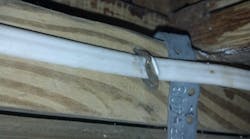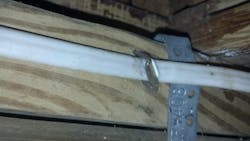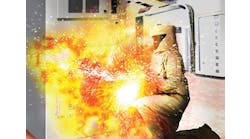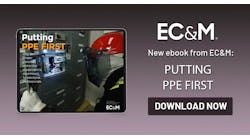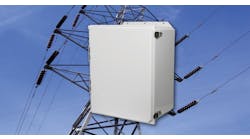The call came in as a “working structure fire.” Upon arrival, we could see smoke billowing out of the walkout basement doors and windows. It was an exciting moment as we made entry, considering it was the first time my son and I had fought a fire together. He was on the nozzle, and I backed him up.
He made a great stop, and the fire was contained to the basement. Once we ventilated the area and the smoke cleared, we began the investigation while other firefighters checked the walls and ceiling for extension. It was there — between the ceiling joists — thatI spotted the fire’s origin. Even after 37 years in the industry, I must admit I was surprised by what I saw.
I noticed that the bare copper wires overhead came to an abrupt stop. On the end of each conductor was a small ball of melted copper. When I laid the conductor against the joist, it perfectly matched up with two small holes in the wood. This is where a staple had been installed to secure the NM cable. Because copper melts at 1,984ºF, it became clear to me what had happened here. The staple that held these wires had been driven in far enough to pinch the conductors. As a result, those conductors heated up enough to cause the wooden joist to ignite.
Now, this hazardous situation did not happen overnight. This fault took time to show its face. Most likely, it took years for the heat to build up to that point (long after the work was out of warranty).
This case reminds us how important it is to pay attention to the smallest of details on the job site (see Sidebar below). Sure, you want your guys to bang out a quick rough-in and get paid. However, as the master electrician, it pays to go back and inspect the work performed under your license. Not only will you sleep better at night, but you also might be saving lives.
Now retired after 40 years in the industry, John Kostick is a licensed master electrician in New Jersey and Delaware. He is also a licensed electrical instructor in New Jersey and a certified fire instructor. He can be reached at [email protected].
SIDEBAR: An NM Menace?
Reflecting back on my early days in the electrical industry, I recall the jobs that every other “new guy” and I were given, such as drilling holes, pulling wire, and stapling wire. You know the ones… the easiest and most mindless jobs that require the least amount of skill.
Most bosses would just point to the wall and say, “That’s where the holes, wire, and staples go.” There was always a box or tub of staples ready to be hammered in. Inevitably, the bosses got busy with more important work and only checked in on you occasionally to make sure you were still working. If you were new, you might get a one-minute lesson on how to install a staple without bashing your fingers with the hammer. Otherwise, you were left alone to complete the job. A typical whole house rough-in could use 1,000 staples or more. Once they were nailed in, they were quickly forgotten.
Securing NM cable is possibly the most important aspect of a dwelling unit wiring project. Staples can twist in hard wood, fold over, or be plunged too deep or tight, pinching or crimping the insulation or flattening the conductors. In some cases, the insulation could be pierced, and the staple can contact the conductors. Unfortunately, there is no depth gauge or standard of what is too tight, and installation is done with many different sizes and shapes of hammers by workers of varying strength. If the installer is not paying attention, is rushing, or is tired, it’s a guarantee that no two staples will be set the same.
